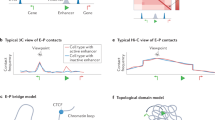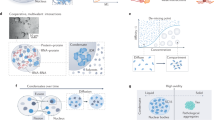Abstract
Regulation of gene expression involves a number of different levels of organization in the cell nucleus. The main agents of transcriptional control are the cis-acting sequences in the immediate vicinity of a gene, which combine to form the functional unit or domain. Contacts between these sequences through the formation of chromatin loops forms the most basic level of organization. The activity of functional domains is also influenced by higher order chromatin structures that impede or permit access of factors to the genes. Epigenetic modifications can maintain and propagate these active or repressive chromatin structures across large genomic regions or even entire chromosomes. There is also evidence that transcription is organized into structures called ‘factories’ and that this can lead to inter-chromosomal contacts between genes that have the potential to influence their regulation.
Similar content being viewed by others
References
Andrulis E, Neiman A, Zappulla D, Sternglatz R (1998) Perinuclear localisation of chromatin facilitates transcriptional silencing. Nature 394: 592–595.
Anguita E, Johnson CA, Wood WG, Turner BM, Higgs DR (2001) Identification of a conserved erythroid specific domain of histone acetylation across the alpha-globin gene cluster. Proc Natl Acad Sci USA 98: 12114–12119.
Belmont A, Dietzel S, Nye A, Strukov Y, Tumbar T (1999) Large scale chromatin structure and function. Curr Opin Cell Biol 11: 307–311.
Boyes J, Felsenfeld G (1996) Tissue-specific factors additively increase the probability of the all-or-none formation of a hypersensitive site. EMBO J 15: 2496–2507.
Bulger M, van Doorninck JH, Saitoh N et al. (1999) Conservation of sequence and structure flanking the mouse and human beta-globin loci: the beta-globin genes are embedded within an array of odorant receptor genes. Proc Natl Acad Sci USA 96: 5129–5134.
Burgess-Beusse B, Farrell C, Gaszner M et al. (2002) The insulation of genes from external enhancers and silencing chromatin. Proc Natl Acad Sci USA 99: 16433–16437.
Bystricky K, Heun P, Gehlen L, Langowski J, Gasser SM (2004) Long-range compaction and flexibility of interphase chromatin in budding yeast analyzed by high-resolution imaging techniques. Proc Natl Acad Sci USA 101: 16495–16500.
Cajiao I, Zhang A, Yoo EJ, Cooke NE, Liebhaber SA (2004) Bystander gene activation by a locus control region. EMBO J 23: 3854–3863.
Caron H, van Schaik B, van der Mee M et al. (2001) The human transcriptome map: clustering of highly expressed genes in chromosomal domains. Science 291: 1289–1292.
Carpenter A, Memedula S, Plutz M, Belmont A (2004) Common effects of acidic activators on large-scale chromatin structure and transcription. Mol Cell Biol 25: 958–968.
Carter D, Chakalova L, Osborne CS, Dai YF, Fraser P (2002) Long-range chromatin regulatory interactions in vivo. Nat Genet 32: 623–626.
Casolari JM, Brown CR, Komili S, West J, Hieronymus H, Silver PA (2004) Genome-wide localization of the nuclear transport machinery couples transcriptional status and nuclear organization. Cell 117: 427–439.
Chambeyron S, Bickmore W (2004) Chromatin decondensation and nuclear reorganization of the HoxB locus upon induction of transcription. Genes Dev 18: 1119–1130.
Cheutin T, McNairn A, Jenuwein T, Gilbert D, Singh P, Misteli T (2003) Maintenance of stable heterochromatin domains by dynamic HP1 binding. Science 299: 721–725.
Chong S, Riggs AD, Bonifer C (2002) The chicken lysozyme chromatin domain contains a second, widely expressed gene. Nucleic Acids Res 30(2): 463–467.
Dillon N (2003) Gene autonomy: position effects continue to raise questions about the physical structure of the particulate Mendelian gene. Nature 425: 457.
Dillon N, Sabbattini P (2000) Functional gene expression domains: defining the functional unit of gene regulation. BioEssays 22: 657–665.
Dillon N, Trimborn T, Strouboulis J, Fraser P, Grosveld F (1997) The effect of distance on long-range chromatin interactions. Mol Cell 1: 131–139.
Dorigo B, Schalch T, Kulangara A, Duda S, Schroeder RR, Richmond TJ (2004) Nucleosome arrays reveal the two-start organization of the chromatin fiber. Science 306: 1571–1573.
Elgin SC (1996) Heterochromatin and gene regulation in Drosophila. Curr Opin Genet Dev 6: 193–202.
Epner E, Reik A, Cimbora D et al. (1998) The β-globin LCR is not necessary for an open chromatin structure or developmentally regulated transcription of the mouse β-globin locus. Mol Cell 2: 447–455.
Festenstein R, Tolaini M, Corbella P et al. (1996) Locus control region function and heterochromatin-induced position effect variegation. Science 271: 1123–1125.
Festenstein R, Pagakis S, Hiragami K et al. (2003) Modulation of heterochromatin protein 1 dynamics in primary mammalian cells. Science 299: 719–721.
Fourel G, Magdinier F, Gilson E (2004) Insulator dynamics and the setting of chromatin domains. Bioessays 26: 523–532.
Gottschling D, Aparicio O, Billington B, Zakian V (1990) Position effect at S. cerevisiae telomeres: reversible repression of Pol II transcription. Cell 63: 751–762.
Greaves DR, Wilson FD, Lang G, Kioussis D (1989) Human CD2 3′-flanking sequences confer high-level, T cell-specific, position-independent gene expression in transgenic mice. Cell 56: 979–986.
Grewal SI, Rice JC (2004) Regulation of heterochromatin by histone methylation and small RNAs. Curr Opin Cell Biol 16: 230–238.
Grosveld F, van Assendelft GB, Greaves DR, Kollias G (1987) Position-independent, high-level expression of the human beta-globin gene in transgenic mice. Cell 51: 975–985.
Grummt I (2003) Life on a planet of its own: regulation of RNA polymerase I transcription in the nucleolus. Genes Dev 17: 1691–1702.
Haynes KA, Leibovitch BA, Rangwala SH, Craig C, Elgin SC (2004) Analyzing heterochromatin formation using chromosome 4 of Drosophila melanogaster. Cold Spring Harbor Symp Quant Biol 69: 267–272.
Heard E (2004) Recent advances in X-chromosome inactivation. Curr Opin Cell Biol 16: 247–255.
Hetzer M, Walther, TC, Mattaj IW (2005) Pushing the envelope: structure, function, and dynamics of the nuclear periphery. Annu Rev Cell Dev Biol 21: 347–380.
Heun P, Taddei A, Gasser SM (2001) From snapshots to moving pictures: new perspectives on nuclear organization. Trends Cell Biol 11: 519–525.
Kelley RL (2004) Path to equality strewn with roX. Dev Biol 269: 18–25.
Kimura H, Sugaya K, Cook PR (2002) The transcription cycle of RNA polymerase II in living cells. J Cell Biol 159: 777–782.
Krajewski W, Becker PB (1998) Reconstitution of hyperacetylated, DNase I-sensitive chromatin characterized by high conformational flexibility of nucleosomal DNA. EMBO Rep 95: 1540–1545.
Labrador M, Corces VG (2002) Setting the boundaries of chromatin domains and nuclear organization. Cell 111: 151–154.
Litt MD, Simpson M, Recillas-Targa F, Prioleau MN, Felsenfeld G (2001) Transitions in histone acetylation reveal boundaries of three separately regulated neighboring loci. EMBO J 20: 2224–2235.
Lundgren M, Chow C, Sabbattini P, Georgiou A, Minaee S, Dillon N (2000) Transcription factor dosage affects changes in higher order chromatin structure associated with activation of a heterochromatic gene. Cell 103: 733–743.
Mahy NL, Perry PE, Gilchrist S, Baldock RA, Bickmore WA (2002) Spatial organization of active and inactive genes and noncoding DNA within chromosome territories. J Cell Biol 157: 579–589.
Marshall WF, Straight A, Marko JF et al. (1997) Interphase chromosomes undergo constrained diffusional motion in living cells. Curr Biol 7: 930–939.
Martin S, Pombo A (2003) Transcription factories: quantitative studies of nanostructures in the mammalian nucleus. Chromosome Res 11: 461–470.
Mayer C, Grummt I (2005) Cellular stress and nucleolar function. Cell Cycle 4: 1036–1038.
McNally J, Muller W, Walker D, Wolford R, Hager G (2000) The glucocorticoid receptor: rapid exchange with regulatory sites in living cells. Science 287: 1262–1265.
Milot E, Strouboulis J, Trimborn T et al. (1996) Heterochromatin effects on the frequency and duration of LCR-mediated gene transcription. Cell 87: 105–114.
Minaee S, Farmer D, Georgiou A et al. (2005) Mapping and functional analysis of regulatory sequences in the mouse lambda5-VpreB1 domain. Mol Immunol 42: 1283–1292.
Osborne C, Chakalova L, Brown K et al. (2004) Active genes dynamically colocalize to shared sites of ongoing transcription. Nat Genet 36: 1065–1071.
Ovcharenko I, Loots GG, Nobrega MA, Hardison RC, Miller W, Stubbs L (2005) Evolution and functional classification of vertebrate gene deserts. Genome Res 15: 137–145.
Peters AH, Schubeler D (2005) Methylation of histones: playing memory with DNA. Curr Opin Cell Biol 17: 230–238.
Peters A, Kubicek S, Mechtler K et al. (2003) Partitioning and plasticity of repressive histone methylation states in mammalian chromatin. Mol Cell 12: 1577–1589.
Philipsen S, Pruzina S, Grosveld F (1993) The minimal requirements for activity in transgenic mice of hypersensitive site 3 of the beta globin locus control region. EMBO J 12: 1077–1085.
Raska I, Koberna K, Malinsky J, Fidlerova H, and Masata M (2004) The nucleolus and transcription of ribosomal genes. Biol Cell 96: 579–594.
Sabbattini P, Georgiou A, Sinclair C, Dillon N (1999) Analysis of mice with single copies and multiple copies of transgenes reveals a novel arrangement for the λ5-VpreB1 locus control region. Mol Cell Biol 19: 671–679.
Schalch T, Duda S, Sargent DF, Richmond TJ (2005) X-ray structure of a tetranucleosome and its implications for the chromatin fibre. Nature 436: 138–141.
Silva J, Mak W, Zvetkova I et al. (2003) Establishment of histone H3 methylation on the inactive X chromosome requires transient recruitment of Eed–Enx1 polycomb group complexes. Dev Cell 4: 481–495.
Singer G, Lloyd A, Huminiecki L, Wolfe K (2005) Clusters of co-expressed genes in mammalian genomes are conserved by natural selection. Mol Biol Evol 22: 767–775.
Spellman PT, Rubin GM (2002) Evidence for large domains of similarly expressed genes in the Drosophila genome. J Biol 1: 5.
Spilianakis C, Lalioti M, Town T, Lee G, Flavell R (2005) Interchromosomal associations between alternatively expressed loci. Nature 435: 637–645.
Spradling AC (1994) Transposable elements and the evolution of heterochromatin. Soc Gen Physiol Ser 49: 69–83.
Szutorisz H, Canzonetta C, Georgiou A, Chow, C-M, Tora L, Dillon N (2005a). Formation of an active tissue-specific chromatin domain initiated by epigenetic marking at the embryonic stem cell stage. Mol Cell Biol 25: 1804–1820.
Szutorisz H, Dillon N, Tora L (2005b) The role of enhancers as centres for general transcription factor recruitment. Trends Biochem Sci 30: 593–599.
Tolhuis B, Palstra RJ, Splinter E, Grosveld F, de Laat W (2002) Looping and interaction between hypersensitive sites in the active beta-globin locus. Mol Cell 10: 1453–1465.
Verschure PJ, van Der Kraan I, Manders EM, van Driel R (1999) Spatial relationship between transcription sites and chromosome territories. J Cell Biol 147: 13–24.
Vogel J, von Heydebreck A, Purmann A, Sperling S (2005) Chromosomal clustering of a human transcriptome reveals regulatory background. BMC Bioinformatics 19: 6:230.
Wallrath L, Elgin S (1995) Position effect variegation in Drosophila is associated with an altered chromatin structure. Genes Dev 9: 1263–1267.
Weiler K, Wakimoto B (1995) Heterochromatin and gene expression in Drosophila. Annu Rev Genet 29: 577–605.
Williams RR (2003) Transcription and the territory: the ins and outs of gene positioning. Trends Genet 19: 298–302.
Woodcock CL, Dimitrov S (2001) Higher-order structure of chromatin and chromosomes. Curr Opin Genet Dev 11: 130–135.
Woodcock CL, Frado LL, Rattner JB (1984) The higher-order structure of chromatin: evidence for a helical ribbon arrangement. J Cell Biol 99: 42–52.
Yang XJ (2004) Lysine acetylation and the bromodomain: a new partnership for signaling. BioEssays 26: 1076–1087.
Author information
Authors and Affiliations
Corresponding author
Rights and permissions
About this article
Cite this article
Dillon, N. Gene regulation and large-scale chromatin organization in the nucleus. Chromosome Res 14, 117–126 (2006). https://doi.org/10.1007/s10577-006-1027-8
Published:
Issue Date:
DOI: https://doi.org/10.1007/s10577-006-1027-8




